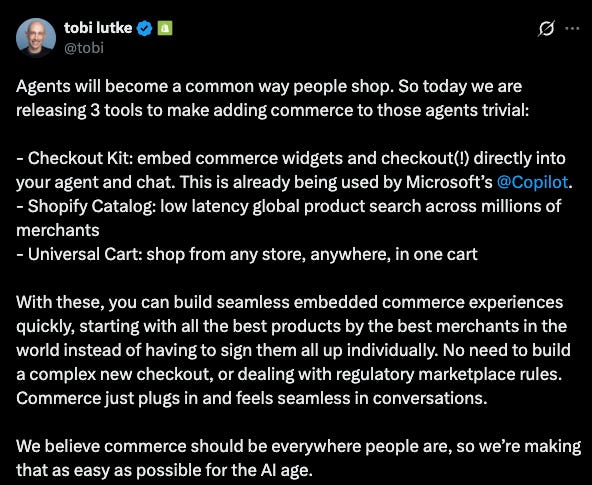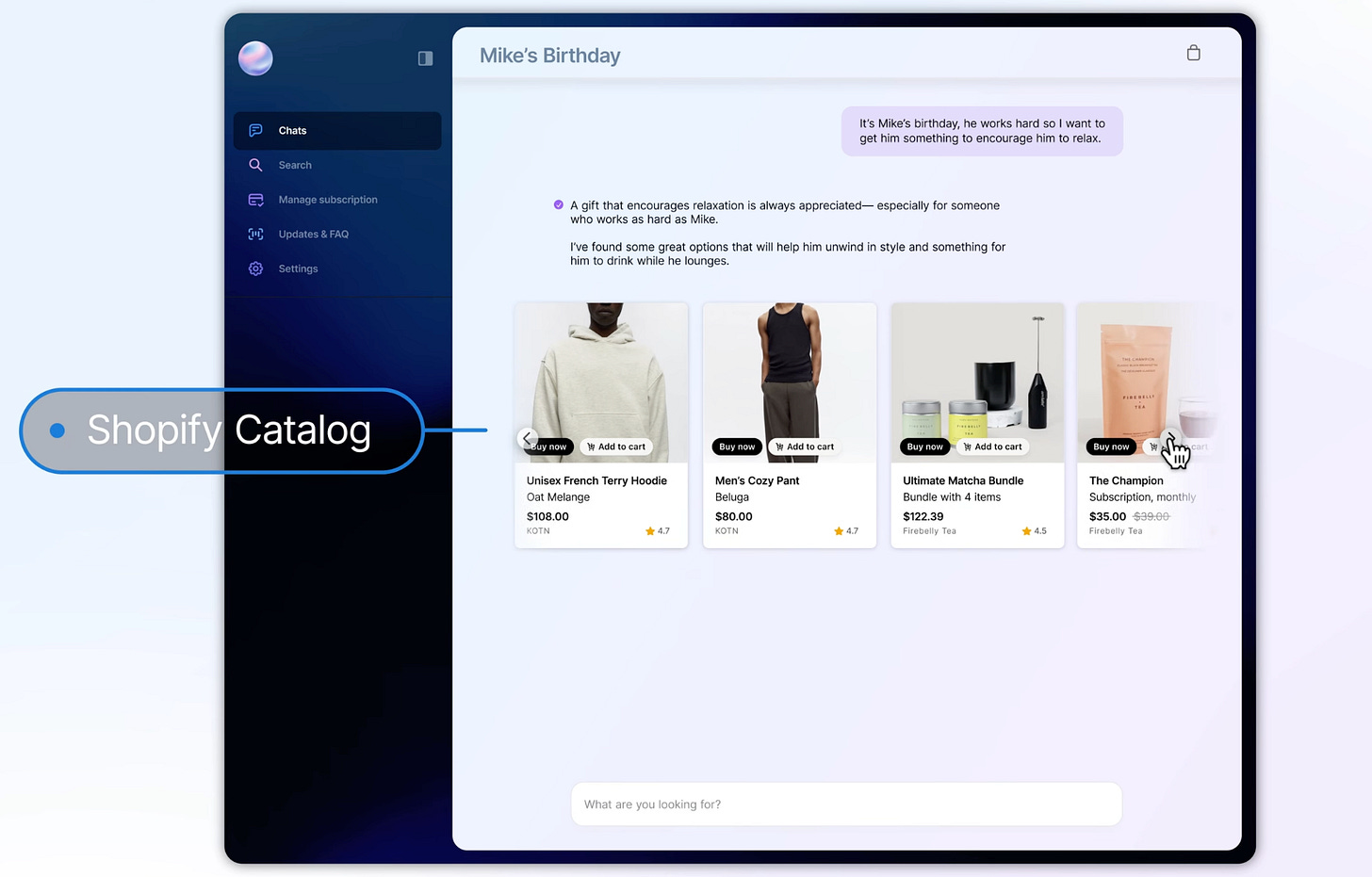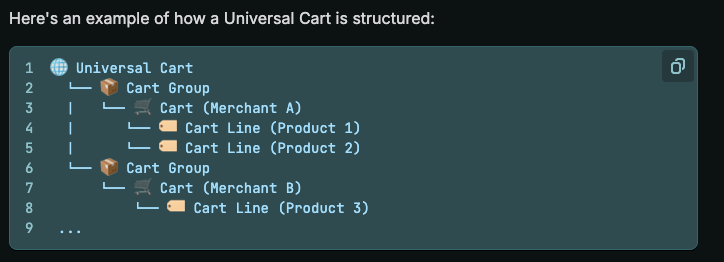Shopify Makes Commerce Agents First-Class Citizens
An announcement we’ve been waiting for finally dropped yesterday – Shopify officially rolled out their agentic commerce tools.
Right now it’s only open to Shopify Partners (you can register here), but we still want to dig into the core capabilities they’re introducing, the benefits, and the challenges that still need to be addressed.
Let’s start with Tobi’s announcement:
The three tools they’re introducing are Catalog, Cart, and Checkout – all available through an MCP server. The names are pretty self-explanatory: Catalog lets you search a merchant catalog, Cart lets you manage a cart session, and Checkout provides a checkout page where end-users can pay and complete checkout.
The gist is that it lets third-party agent developers (not the store owners themselves) search products across Shopify’s entire merchant catalog (hundred of millions of products), manage a cart, and handle checkout. The agent developer doesn’t need any compliance or things like PCI, and the technical onboarding is probably very easy. And since Shopify has millions of merchants, this instantly lets you build commerce agents that work out of the box, batteries included.
A buyer will be able, using a chat interface, to describe what they want (“Get me a pair of running shoes, size 13, in the style of…”) and the agent, via the MCP, will be able to show products, render them visually, and let the user click ‘Add’ to add to cart. Eventually, the user can click ‘Checkout’ which opens a new page with the checkout form.
An example from Shopify Youtube:
There’s also one particularly interesting technology we already covered in a previous blog post – MCP UI. It’s a standardized way of rendering UI components. This means the products the agent fetches from the catalog can be displayed visually inside the agent app. The way it works is the the MCP server, alongside the MCP response, sends the agent the instructions of which components to render and how.
There are some great examples of this here, and you can also see one below:
There are two really major benefits of Shopify agentic commerce tools:
we can finally build agentic commerce experiences that work end-to-end without stitching everything together. Today, commerce agent developers who want to build such experiences usually have to patch together a catalog (sometimes based on scraping), manage a virtual cart themselves, and handle a manual remote checkout. While it’s possible, it still requires technical proficiency and some level of effort. Shopify’s tools will probably be much easier to integrate.
It introduces wide usage in MCP-UI, which creates rich agentic commerce experiences: real agentic commerce experiences shouldn’t just rely on text (most shoppers don’t shop this way) but also on visuals. It combines the best of both worlds, and it uses a really elegant standard that OpenAI are also embedding with ChatGPT checkout.
There are also some challenges that we recognize here:
Lack of universality: Although Shopify deliberately called the cart “Universal Cart” and mentioned you can add non-Shopify products, it’s not actually possible right now to purchase from other non-Shopify merchants using this cart instance. If the agent developer is using another catalog API, any product outside the Shopify catalog can’t actually interact with the Shopify Universal Cart. The same goes for checkout, which only works for Shopify merchants. This means an agent developer who wants to support both Shopify merchants and other merchants will still need to reimplement their own cart and build a system around checkout that works universally across merchants. The fact that Shopify is mentioning non-Shopify products in the universal cart suggests they’re probably aiming that their cart will sort of semantically be universal, although the checkout systems will for this moment be fragmented. In our previous blog post, we suggested an approach for headless checkouts that could solve this and unify the checkout experience across merchants and merchant ecosystems like Shopify. We believe this is the right approach to enable checkout universality.
Fragmented checkout across merchants: The dev page examples show you can add items from different merchants to your cart (this could be a very cool feature for a fashion agent, creating your wardrobe from multiple merchants). But each one still requires a separate checkout - meaning a new checkout page, re-entering payment credentials, and clicking ‘buy’ again. This is a byproduct of the catalog being “universal” on the surface, but underneath it’s really an aggregation layer of millions of separate merchants. For this UX friction to be solved in the future, there will need to be some consolidation layer that executes all checkouts at once.
Lack of merchant control: The first two issues affect the agent developer, but there’s another one that could become tricky in the near future: lack of merchant control. Shopify was built on the idea of “arming the rebels” - giving small merchants power against giants like Amazon. This feels like a trend reversal. Many merchants are now funneled into the narrow pipe of the MCP. There are millions of merchants in the catalog, but only room for a few in the MCP UI visuals. Who gets shown first? Will Shopify merchants need to compete with each other to climb the Shopify catalog search ladder? It’s too early to flag as a real problem, but it could create friction in the future. It will be interesting to see how this plays out.
Is this the zero-to-one moment for agentic commerce?
Well, yes :) Alongside Perplexity and ChatGPT introducing checkout into their apps, it definitely feels like 2025 is the year agentic commerce becomes real. What we’re seeing now is just a small glimpse of a much bigger future that’s unfolding at a rapid pace.
Shopify are the first to make third party commerce agents first-class citizens. They are the fastest moving company in the internet commerce space, and we expect many other companies to follow suite soon. So stay tuned and subscribe to learn more about agentic commerce.
If you’re building a commerce agent and want to embed payments, reach out at founders@nekuda.ai to get access to the nekuda sdk.






Great post!